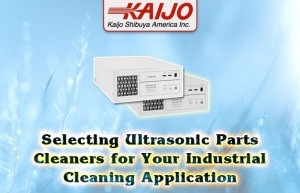Selecting Ultrasonic Parts Cleaners for Your Industrial Cleaning Application
June 29, 2016
 Ultrasonic cleaners work by generating ultrasonic acoustic waves into a cleaning solution. During the expansion phase of the wave, the low pressure results in cavitation bubbles in the liquid while the subsequent compression phase collapses the bubbles suddenly. This bubble action removes impurities and contamination from surfaces to be cleaned. Ultrasonic parts cleaners are fast and cost-effective, eliminating the use of harsh chemicals and the mechanical scrubbing required for traditional cleaning solutions.
Ultrasonic cleaners work by generating ultrasonic acoustic waves into a cleaning solution. During the expansion phase of the wave, the low pressure results in cavitation bubbles in the liquid while the subsequent compression phase collapses the bubbles suddenly. This bubble action removes impurities and contamination from surfaces to be cleaned. Ultrasonic parts cleaners are fast and cost-effective, eliminating the use of harsh chemicals and the mechanical scrubbing required for traditional cleaning solutions.
Low frequency cleaners using ultrasonic frequencies of 26 kHz or 38 kHz use a much longer wavelength than high frequency cleaning systems operating above 200 kHz or in the MHz range. With a lower frequency and longer wavelength, there is more time for the bubbles to grow and the energy with which they collapse is higher. At the highest frequencies the bubbles are very small and the cleaning action from the collapse of the bubbles is very gentle. While cleaning intensity is controlled by the frequency, the number of bubbles depends on the power of the ultrasonic parts cleaner. High power units work faster and can handle larger parts while low power cleaners are for small systems.
Low Frequency Ultrasonic Parts Cleaners for Robust Cleaning
Kaijo ultrasonic cleaning systems such as those using the Phenix III ultrasonic generator operate at 26 kHz or 38 kHz and are suited for the cleaning of robust parts with stable surfaces. If an ultrasonic parts cleaner is used for parts that are not suitable, surface pitting can result and the parts may be damaged. Systems based on the Phenix III are suitable for cleaning machined parts, ceramics, glass, medical devices and jewelry. The generator is available with outputs of 600 W and 1200 W for cleaning parts of different sizes and the corresponding tanks can hold small or large parts.
Systems such as those based on the Phenix III generator are suitable for general purpose cleaning in a manufacturing environment that does not deal with delicate parts. An ultrasonic parts cleaner suitable for a wide variety of applications, the flexible Phenix III is a cost effective and reliable solution. It can be purchased as an immersible set for an existing tank or in a turnkey configuration with Kaijo transducers and tanks designed specifically to work with the ultrasonic generator.
High Frequency Cleaning for Delicate Parts
High frequency ultrasonic cleaners are used for parts that could be damaged by the robust bubble action present at 26 kHz and 38 kHz and for light surface contamination. Frequencies up to the MHz range can clean parts such as printed circuits, semiconductor components, optical components and precision-machined parts. The cleaning action is powerful enough to remove surface films and particles down to sub-micron sizes but gentle enough so that relatively soft surfaces and microscopic details are not affected.
Ultrasonic cleaners such as the Kaijo Quava models can generate a wide variety of frequencies and powers to deliver the specific cleaning intensity and power required for a particular application. Decision makers and production managers in manufacturing plants that have part cleaning requirements have to decide whether to purchase a low-frequency all-purpose ultrasonic parts cleaner for robust cleaning, a high-frequency model if only delicate parts are to be cleaned, or a general purpose parts cleaner able to generate both low and high frequencies. Kaijo’s ultrasonic parts cleaners are available to cover all these needs. If you need more information on any of Kaijo’s products and want a quote call 408-675-5575 or email info@kaijo-shibuya.com.





